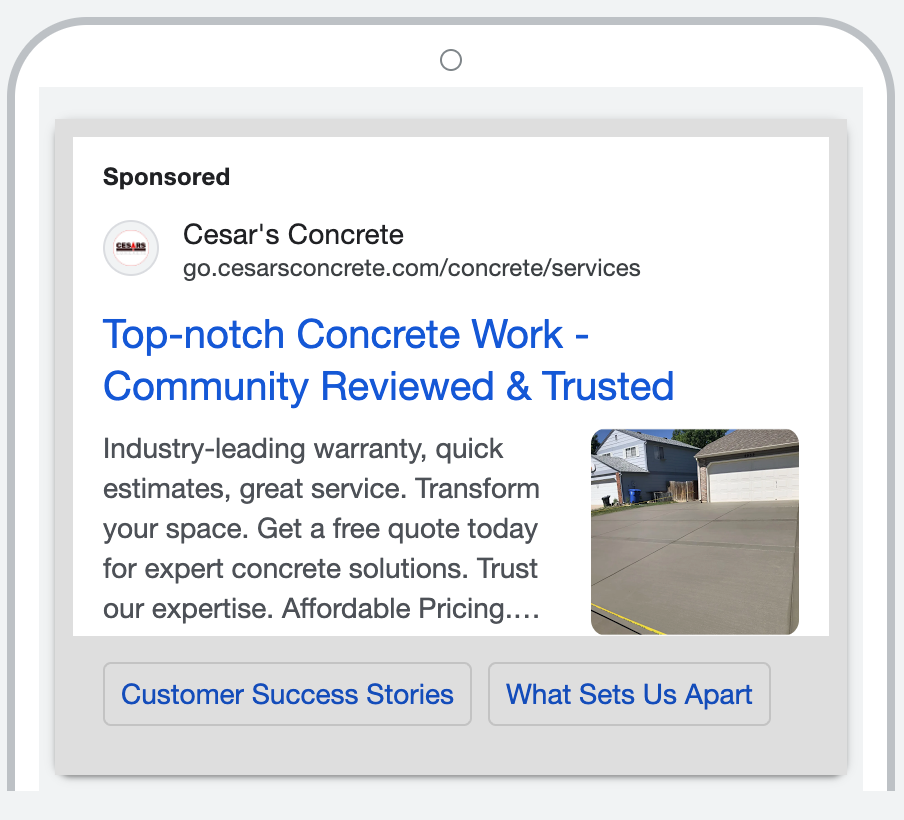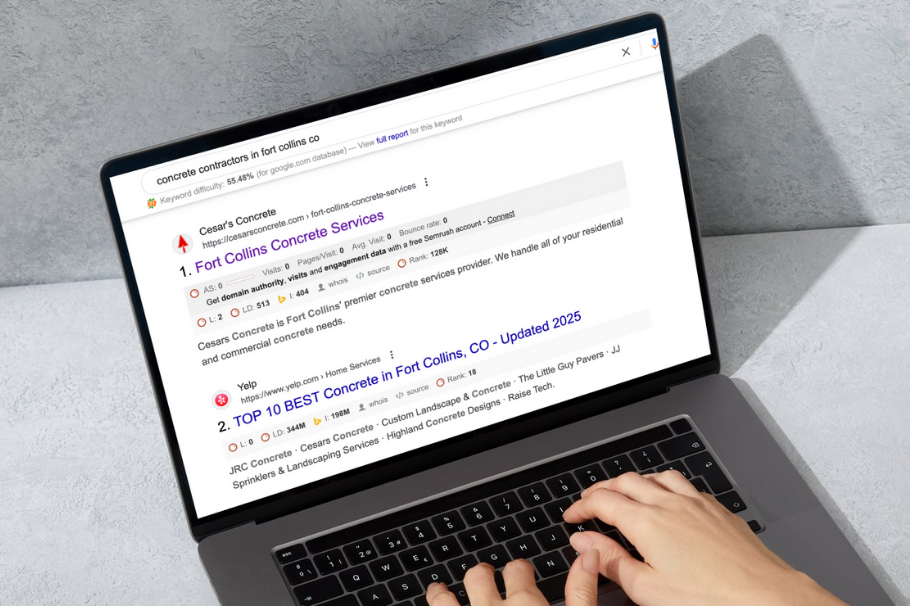Google Ads for Contractors: Is It Really Worth It?
As a contractor, you might often wonder if Google Ads is the right move for your business. With so many digital marketing options available, it can be challenging to decide where to invest your hard-earned money. In this blog, we will delve deep into Google Ads, how it works for contractors, and whether it’s a worthy investment. By the end, you'll have a comprehensive understanding of whether Google Ads is the right fit for your contracting business.
What Are Google Ads?
Google Ads is an online advertising platform developed by Google. It allows advertisers to bid on displaying brief advertisements, service offerings, product listings, or videos to web users. This system can place ads in the results of search engines like Google Search and on non-search websites, mobile apps, and videos.
Key Features of Google Ads:
- Pay-Per-Click (PPC): You only pay when someone clicks on your ad.
- Targeting Options: Tailor your ads based on demographics, location, interests, and more.
- Ad Formats: Text, image, video, and shopping ads.
- Analytics: Detailed insights and performance metrics.
Why Google Ads Can Be Beneficial for Contractors
Google Ads offers several advantages that can be particularly beneficial for contractors. Here’s why:
1. Reach Potential Customers Quickly
With Google Ads, your business can appear on the first page of search results almost instantly. For instance, if someone searches for "roof repair near me," your ad can show up at the top of the search results. This is incredibly powerful because it puts your business in front of people actively looking for your services.
2. Precise Targeting
Google Ads allows you to target your ads to specific geographical locations. For a contractor, this means you can focus on areas where you offer your services, ensuring your ads are seen by the right people. Moreover, you can use keywords relevant to your business, making it easier to reach potential customers searching for those specific services.
3. Get in Front of Customers Who Are Already Searching for You
One of the best things about Google Ads is that it helps you reach people who are already looking for your services. When someone types in specific words related to your business, your ad can show up right when they need it. This means you're connecting with people who are very interested and ready to hire, making it easier to turn them into actual customers. This makes your ads much more effective.
4. Budget Control
One of the significant advantages of Google Ads is the ability to control your budget. You can set a daily budget and adjust it as needed. This means you can start small, test what works, and scale your investment as you see positive results.
5. Measurable Results
Google Ads provides detailed analytics, allowing you to track the performance of your campaigns. You can see how many people viewed your ads, how many clicked on them, and what actions they took after clicking. This data is invaluable for optimizing your campaigns and maximizing your return on investment (ROI).
Case Study: Success with Google Ads
The Case of Cesar's Concrete

Cesar's Concrete, a contracting business based in Northern Colorado, decided to invest in Google Ads to generate qualified leads. They started with clear goals and budget parameters. Here’s what they achieved:
- Weekly Conversions: They aimed for 10-20 weekly conversions through calls, form submissions, and service inquiries.
- Cost per Conversion: They maintained a cost per conversion between $20 and $25, ensuring maximum value from their ad spend.
- Cost-Per-Click (CPC): They strategically managed bids to maintain CPC between $0.30 to $1.00, ensuring quality traffic without overpaying.
- Click Through Rate (CTR): They targeted a CTR of 3% to 5%, beating the industry standard with effective ad targeting and engaging content.
Cesar's Concrete Performance Metrics
| Metric | Target | Achieved |
|---|---|---|
| Weekly Conversions | 10-20 | 20 |
| Cost per Conversion | $20-$25 | $22 |
| Cost-Per-Click (CPC) | $0.30-$1.00 | $0.75 |
| Click Through Rate (CTR) | 3%-5% | 4.2% |
This example illustrates how even a small investment in Google Ads can yield significant results for contractors.
Costs Involved in Google Ads
The cost of Google Ads can vary widely depending on several factors, including the competitiveness of your industry, the keywords you target, and your geographical location. Here’s a breakdown of the typical costs involved:
1. Cost-Per-Click (CPC)
CPC is the amount you pay each time someone clicks on your ad. In the contracting industry, the average CPC can range from $1 to $4 for common keywords. However, highly competitive keywords can cost significantly more.
2. Budgeting
You can set a daily budget to control how much you spend each day. For example, if your daily budget is $20, Google will stop showing your ads once that limit is reached.
3. Additional Costs
Besides CPC, you may need to consider costs for professional services if you hire an expert to manage your campaigns. This can include setup fees, monthly management fees, and costs for creating ad content.
Monthly Budget Recommendations for Contractors
| Budget | Expected Clicks |
|---|---|
| $500 | 250-400 |
| $1,000 | 500-800 |
| $2,000 | 1,000-1,600 |
| $5,000 | 2,500-4,000 |
(Source: HubSpot)
Comparing Google Ads to Other Marketing Strategies
It’s essential to compare Google Ads with other marketing strategies to determine its effectiveness. Here’s a quick comparison:
Google Ads vs. SEO
- Speed: Google Ads offers instant results, whereas SEO takes time to build and show results.
- Cost: Google Ads requires ongoing investment, while SEO can be more cost-effective in the long run.
- Control: Google Ads provides more control over visibility, while SEO relies on search engine algorithms.
Google Ads vs. Social Media Advertising
- Targeting: Both offer precise targeting, but Google Ads can reach users actively searching for services.
- Engagement: Social media ads can be more engaging and interactive.
- ROI: Google Ads often have a clearer ROI due to direct user intent.
Should I Choose Facebook Ads or Google Ads for My Business?
When deciding between Facebook Ads and Google Ads for your business, it's important to know what each platform does best. Facebook Ads are great for targeting specific groups of people based on their interests and behaviors. This makes them perfect for building brand awareness and engaging with potential customers in a fun and interactive way. Plus, Facebook Ads come in different formats like images, videos, carousels, and slideshows, so you can get creative with how you showcase your services.
On the other hand, Google Ads are powerful for reaching people who are actively looking for your services. When someone searches for something specific on Google, like "driveway repair near me," your ad can appear right at the top of the search results. This helps you connect with people who are ready to make a decision. From our experience, we think Google Ads are a great fit for contractors because they help you get more calls and inquiries from people who need your services right now. Plus, the detailed analytics show you what's working and what needs tweaking. While Facebook Ads are great for building awareness, Google Ads seem to bring in more direct leads, making them a valuable tool for growing your contracting business.
Tips for Contractors Using Google Ads
To make the most out of your Google Ads investment, consider these tips:
1. Use Relevant Keywords
Choose keywords that are directly related to your services. Tools like Google Keyword Planner can help you find the right keywords.
Utilizing Keyword Research Tools
Keyword research tools can help you find new keywords and analyze their performance. One such tool, SEMrush, allows you to discover the top keywords, see the search volume, and understand what you can expect to pay per click for the keywords you want to target. Another helpful tool is Spyfu, which helps you discover the ads and keywords your competitors are using, which ones are performing best, and an estimate of how much they are spending per month. Using tools like these, you can determine which keywords are worth targeting and which are not. They can also help you discover long-tail keywords (we’ll explain this below) that are more specific to your business and have less competition, making it easier for your ads to rank.
Long-Tail Keywords for More Specific Targeting
Long-tail keywords are more specific keyword phrases with lower search volume but are highly targeted. These keywords can help you reach potential clients who are further down the sales funnel and have a higher intent to buy. For example, instead of targeting “custom home builders,” you can target “custom home builders near me” or “custom home builders in Los Angeles.” By targeting long-tail keywords, you can create more targeted ads that are more likely to be clicked and have a higher conversion rate. Long-tail keywords also have less competition, making them a cost-effective choice for your ad campaigns.
2. Create Compelling Ads
Creating compelling ads is essential for a successful Google Ads campaign. Your ad copy should be clear and compelling, highlighting the unique benefits of your services. Use strong, action-oriented language that encourages users to click on your ad. A strong call to action (CTA) is crucial. Phrases like "Get a Free Quote," "Call Us Today," or "Learn More" can significantly increase your click-through rates. Additionally, using ad extensions can enhance your ads by providing extra information like phone numbers, site links, and location details, making it easier for potential customers to reach you.
For more tips on crafting compelling ad copy, check out WordStream's guide.
3. Optimize Landing Pages
Optimizing your landing pages is just as important as creating compelling ads. Your landing page is where potential customers will end up after clicking your ad, so it needs to be effective at converting visitors into leads. Make sure your landing pages have clear and concise content that directly relates to the ad they clicked on. Include strong CTAs, easy-to-find contact information, and customer testimonials to build trust. Additionally, ensure your landing pages are mobile-friendly, as a significant portion of users will be accessing your site from their mobile devices.
For best practices on optimizing landing pages, refer to Unbounce's landing page optimization tips.
4. Monitor and Adjust
Regularly monitoring and adjusting your Google Ads campaigns is vital for sustained success. Start by analyzing performance data to understand which ads, keywords, and targeting options are working best. Use this data to make informed decisions on where to allocate your budget. Adjust bids to maximize ROI and test different ad copies to see which ones resonate more with your audience. Additionally, keep an eye on your Quality Score, a metric Google uses to determine the relevance and quality of your ads and keywords. A higher Quality Score can lead to lower CPCs and better ad placements.
For a comprehensive guide on monitoring and optimizing Google Ads campaigns, visit Google’s official guide.
How to Set Up Google Ads
Setting up Google Ads for contractors involves several steps. Here’s a quick guide to get you started:
1. Create a Google Ads Account
Visit Google Ads and sign up for an account. You’ll need to provide some basic information about your business.
2. Define Your Goals
Determine what you want to achieve with your Google Ads campaign. This could be increasing website traffic, generating leads, or boosting sales.
3. Choose Your Keywords
Use tools like Google Keyword Planner to select keywords relevant to your services. Focus on keywords that have a good balance of search volume and competitiveness.
4. Write Your Ads
Create compelling ad copy that highlights the benefits of your services. Make sure to include a strong call to action.
5. Set Your Budget
Decide how much you want to spend on your campaign. Set a daily budget that aligns with your overall marketing budget.
6. Launch Your Campaign
Review all the settings and launch your campaign. Monitor its performance and make adjustments as needed.
Common Mistakes to Avoid with Google Ads
While Google Ads can be highly effective, there are common mistakes that contractors should avoid:
1. Ignoring Negative Keywords
Negative keywords prevent your ads from showing up for irrelevant searches. For example, if you offer high-end home renovations, you might want to exclude keywords related to "cheap" or "DIY."
2. Not Tracking Conversions
Without tracking conversions, you won’t know if your ads are generating leads or sales. Use Google Analytics to measure the effectiveness of your campaigns.
3. Overlooking Ad Extensions
Ad extensions provide additional information and can increase the click-through rate of your ads. Use extensions like call buttons, location information, and site links to enhance your ads.
4. Setting and Forgetting
Google Ads requires regular monitoring and adjustments. Don’t set up your campaign and forget about it. Continuously optimize your ads for better performance.
Final Thoughts: Is Google Ads Worth It for Contractors?
Google Ads can be a very effective tool for contractors. It offers quick visibility, precise targeting, and measurable results. With Google Ads, your business can appear at the top of search results when people are looking for your services. This means more potential customers see your ads. You can target specific locations, times, and even types of customers. This helps ensure your ads reach the right people. Google Ads also provides detailed analytics so you can track how your ads are performing and make adjustments to improve your results. This data-driven approach helps you get the best return on your investment.
However, using Google Ads does require ongoing effort and investment. You need to regularly check your campaigns, adjust bids, and optimize your ad copy and landing pages. This might seem like a lot of work, but the benefits can be significant. By continually refining your approach, you can achieve better results and lower costs over time. Google Ads can help you reach a larger market and attract new customers who might not find you through traditional methods. In conclusion, while it takes time and resources, Google Ads can be a valuable tool for growing your contracting business.
Your Next Step
Ready to boost your contracting business with Google Ads? Start today and see the difference it can make. For expert guidance and management of your Google Ads campaigns, contact Contractor CEO now!



